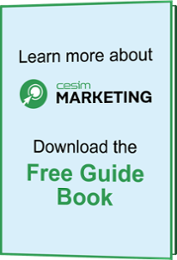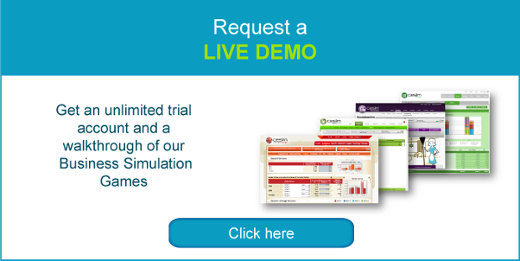 The academic field of marketing is a vast pool of interrelated concepts and theories from areas such as the marketing environment, market research and new product development, marketing tactics and strategy, marketing mix, customer segmentation, customer management and more.
The academic field of marketing is a vast pool of interrelated concepts and theories from areas such as the marketing environment, market research and new product development, marketing tactics and strategy, marketing mix, customer segmentation, customer management and more.
Cesim Marketing is a browser based marketing management simulation game, that incorporates a range of concepts from the field of marketing to help participants understand of the interconnectedness of business decisions in a fast moving and competitive environment. The case company is a smartphone developer with a presence in both the European and Asian markets.
If you are looking for a comprehensive marketing simulation game and are interested in whether this one is suitable for your course or training program, read on to find out.
Below is a non-exhaustive list of concepts from marketing theories that can be illuminated and practiced with Cesim Marketing:
1. Business Objectives (SMART)
All businesses need to set objectives for themselves or for the products or services they are launching. What does your company, product or service hope to achieve?
These are the kind of questions that participants will have to answer in Cesim's marketing simulator, and one great way to do it is by utilizing the SMART system. This simple acronym stands for Specific, Measurable, Achievable, Realistic and Time.
Make sure your students understand the importance of objective setting, and how it helps the company focus on specific aims over a period of time and can motivate staff (in this case team mates) to meet the objectives set.
2. PEST Analysis
Because each round starts with a new market outlook that helps participants determine the likely development of the market, this is a great opportunity for doing a PEST analysis (political, economical, social, technological).
3. Competitor Analysis
The multiplayer environment of Cesim's marketing game allows for a very unpredictable market development based on your competitor's decisions from round to round.
This fact warrants regular competitor analyses that the teams have to conduct in order to stay ahead of the curve and be able to pivot their strategies against that of competing teams.
4. Microenvironmental Factors
Otherwise known as stakeholder analysis, the microenvironmental factors include customers, employees, competitors, media, shareholders, suppliers, and the company.
In Cesim Marketing, participants will be exposed to the customer, competitor and the company (their own) factors, and the interconnectedness between them.
5. Objectives, Strategy and Planning
The teams will take over as the new management team of a global mobile device marketing company. The team is responsible for developing and implementing the company’s marketing strategy, including product portfolio, market segmentation, product positioning, channel decisions, and R&D.
The essence of the business strategy game is to mirror a fast developing, technology- based product market that is driven by short product life cycles and innovation; where constant attention to product development, good timing and successful positioning are the keys to success.
The main objective for the teams is to maximize shareholder value. This is measured by the share price. Share price is the same for each team in the beginning of the simulation and it will change during the simulation in accordance with the teams’ success in the markets. Teams can not issue new shares or repurchase existing shares in this simulation.
In summary, the teams should aim for sustainable and profitable growth.
6. Market Research
Market research involves researching specific industries or markets. It is the only tool an organization has to keep in contact with its external operating environment. In order to be proactive and change with the environment, certain questions need to be asked: How are competitors operate within the environment? Are their strategies exceeding or influencing ours? What should you do?
In Cesim's marketing business game, the market research that unveils how the participants products are doing on the market vis à vis competitors is available under the Results tab for no additional charge to the virtual companies.
7. New Product Development
Product portfolio decisions are crucial. At any point during the marketing strategy simulation game, the team can have a maximum of 6 products in its portfolio. Products can be sold in Europe, Asia, or both.
Product decisions:
- Product name
- Market selection
- Upgrade (if you want to keep existing product do not click upgrade)
- Design (one design only)
- Features (one or more features)
- Compactness level (higher is better)
- Battery life level (higher is better)
8. The Marketing Mix (4 P's)
Decisions regarding product, price, promotion and place complete one of the most well-known marketing concepts; the marketing mix.
It is a tool used by the teams to assist them in pursuing their objectives by carefully managing these four controllable variables to meet the needs of the defined target groups.
The teams in Cesim's business marketing game will have to carefully analyze the four available market segments in order to design desirable, correctly priced, well promoted, and properly placed products.
9. Marketing Budgets
There are a number if ways in which firms can calculate how much to allocate to their marketing and advertising spend. These methods are:
- The objective and task method
- Competitive parity method
- Percentage of sales approach
Each of these can be applied in Cesim's marketing simulation, and then compared to measure the level of relative effectiveness to each other.
10. Consumer Buying Behavior
What influences consumers to purchase products or services? The consumer buying process is a complex matter, as many internal and external factors have an impact on the buying decisions of the consumer.
When purchasing a product, there are several steps the consumer goes through. These are:
1. Problem/Need Recognition
2. Information Search
3. Evaluation of Different Purchase Options
4. Purchase Decision
In order to capture a big market share, teams in Cesim's business marketing simulation have to make sure that their offering is aligned with what the customers want, but are also susceptible to the possibly more desirable offerings of competitors.
11. Market Segmentation, Positioning, Targeting
The case company in Cesim's marketing game simulation can operate in two markets, Europe and Asia. The markets are of different size and have different growth rates.
There are four different customer segments in both markets (more detailed information in the marketing research report):
- Households
- High-end households
- Companies
- High-end companies
The simulation game includes a product positioning tool that allows you to compare your own product positioning with that of the competing teams. Separate maps are available for both Europe and Asia.
12. SWOT Analysis
This tool is used by organizations to help the firm establish its Strengths, Weaknesses, Opportunities, and Threats. A SWOT analysis is used as a framework to help the firm develop its overall corporate, marketing, and product strategy.
In the simulation this can be done after the first practice round, when the participants have been familiarized with the game environment, and then reviewed from round to round.
13. BCG Analysis
This product portfolio matrix classifies product lines into four categories. It suggests that organizations should have a healthy balance of products within their range. The classifications are:
- Dogs
- Question Mark/Problem Child
- Star
- Cash Cow
Cesim Marketing offers a great opportunity for students to practice this particular marketing concept by positioning their products accordingly.
14. Product Life Cycle
The product life cycle concept suggests that a product passes through four stages of evolution:
- Introduction
- Growth
- Maturity
- Decline
The smartphones of the Cesim marketing simulation game follow this curve as well, thus illuminating the different strategies companies have to take during each phase of the cycle.
15. Ansoff's Matrix
A common tool used within marketing was developed by Igor Ansoff in 1957. He suggested that a business can grow in one of four ways, from the lowest risk to a high risk strategy of growth.
These are:
- Market Penetration
- Product Development
- Market Development
- (Diversification)
Although Cesim Marketing doesn't allow for the diversification aspect of Ansoff's matrix (the companies cannot decide to start selling something else other than smartphones), the other three strategies can be pursued and practiced throughout the course of the simulation.
Related article: Why Marketing Simulations Matter - An Interview With Ross Brennan


